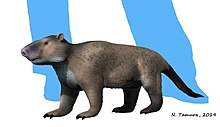| Ernanodontidae Temporal range: middle to late Paleocene | |
|---|---|
 | |
| Reconstruction of Ernanodon antelios | |
| Scientific classification | |
| Domain: | Eukaryota |
| Kingdom: | Animalia |
| Phylum: | Chordata |
| Class: | Mammalia |
| Order: | † Palaeanodonta |
| Family: | † Ernanodontidae Ding, 1979 [1] |
| Type genus | |
| † Ernanodon Ding, 1979 | |
| Genera | |
Ernanodontidae ("sprouts of toothless animals") is an extinct family of myrmecophagous placental mammals within extinct order Palaeanodonta, that lived in Asia from the middle to late Paleocene. [2] [3]